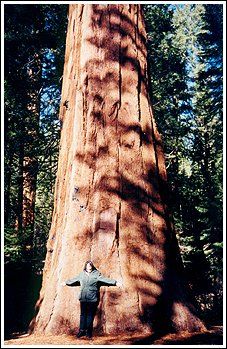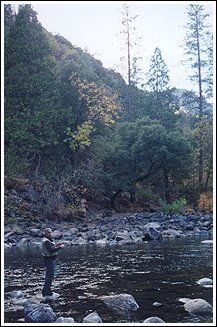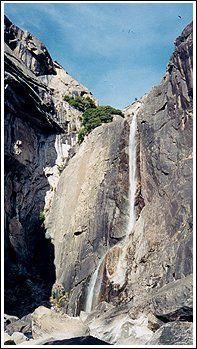My Heart & Soul Belongs to Yosemite
My Heart & Soul Belongs to Yosemite
By Dan Fallon
 Those fly fisher faithful who have followed this column in the past year are aware of my personal soul connection to Yosemite National Park. I have wondered around this otherworldly bastion of natural beauty and wildlife for many years. The park is home to several species of trout including the rare Golden Trout, which I have found only in the rough back country on special occasions. Before I begin this months update with a blow by blow account of the last week spent fly fishing the last trickle of the mighty Merced River. I urge those who wish to understand this surreal place in respect to the trout fishery, please access the contents page of this webzine and read my article titled "Trout Take Over Yosemite in The Fall". This work is a fair overview of the cornucopia of fly fishing available to the general public. It has always amazed me that less then one percent of the millions of park visitors each year pursue the aquatic creatures which are abundant and in many cases wild strains. I suppose its a good thing the restless hordes are not carrying fly rods with their little cameras. This trout repository is to my eyes in fine shape and virtually unmolested.
Those fly fisher faithful who have followed this column in the past year are aware of my personal soul connection to Yosemite National Park. I have wondered around this otherworldly bastion of natural beauty and wildlife for many years. The park is home to several species of trout including the rare Golden Trout, which I have found only in the rough back country on special occasions. Before I begin this months update with a blow by blow account of the last week spent fly fishing the last trickle of the mighty Merced River. I urge those who wish to understand this surreal place in respect to the trout fishery, please access the contents page of this webzine and read my article titled "Trout Take Over Yosemite in The Fall". This work is a fair overview of the cornucopia of fly fishing available to the general public. It has always amazed me that less then one percent of the millions of park visitors each year pursue the aquatic creatures which are abundant and in many cases wild strains. I suppose its a good thing the restless hordes are not carrying fly rods with their little cameras. This trout repository is to my eyes in fine shape and virtually unmolested.
 When I thought about where I would like to perhaps catch and release my last trout of this Millennium. It was about as easy as imagining what Bill Clinton’s schedule might be on new interns day ? The park is in bright color Fall foliage and the millions of tourists are all snuggled up to family and friends waiting for that expensive new Millennium Champagne to chill. The drive to the park for me is like a visceral trip back into my fly fishing education. Yosemite and upper California area’s such as Merced River and of course Fall River, Hat Creek, and all points North were my liquid blackboard in regard to fly fishing. This last trip before Y2k was much anticipated because I would be throwing flies at Brown Trout and Rainbows, whose genetic past can be traced back to the gold miners who first introduced trout by way of hand carried buckets. My sweetheart and life partner Dianne Lund and I would be visiting our good friends Dr. Mike Martin and his avid fly fisher wife lady Karen (both of whom have been featured in past columns). We stopped at the world famous Tenaya Lodge located at Fish Camp 1122 Hiway 41. This authentic old world lodge is the place to rest after sight seeing and hiking.
When I thought about where I would like to perhaps catch and release my last trout of this Millennium. It was about as easy as imagining what Bill Clinton’s schedule might be on new interns day ? The park is in bright color Fall foliage and the millions of tourists are all snuggled up to family and friends waiting for that expensive new Millennium Champagne to chill. The drive to the park for me is like a visceral trip back into my fly fishing education. Yosemite and upper California area’s such as Merced River and of course Fall River, Hat Creek, and all points North were my liquid blackboard in regard to fly fishing. This last trip before Y2k was much anticipated because I would be throwing flies at Brown Trout and Rainbows, whose genetic past can be traced back to the gold miners who first introduced trout by way of hand carried buckets. My sweetheart and life partner Dianne Lund and I would be visiting our good friends Dr. Mike Martin and his avid fly fisher wife lady Karen (both of whom have been featured in past columns). We stopped at the world famous Tenaya Lodge located at Fish Camp 1122 Hiway 41. This authentic old world lodge is the place to rest after sight seeing and hiking.
I must mention two people who were very helpful in getting me up to speed about park water conditions and latest trout fly fishing reports. Tenaya Lodge Marketing specialist Debbie Bryson and culinary dispersalist Mike Robinson spent much time going over latest trout reports. In the historic town of Mariposa just outside the park I got lucky and found a real fly shop called Yosemite Angler owned and operated by Jim Piatto. This guy knows where all the trout within 50 miles will be dining at any given time. The phone number for Tenaya Lodge is 1-800-635-5807 and the number for Yosemite Angler is 1-209-966-8377.I found the following size 22 or smaller flies especially well tied at Jim’s tackle store.
STEALTH SMEALTH
Several mosquitoes, hoppers in larger sizes, brown and grey hackled versions of Royal Coachmen, Midges, and Wolly Buggers dressed in black, size 16. The tiny flies were what would naturally be most needed because the Merced River water level is at its lowest this time of year. The waters flow from the higher reaches of the park and in the Spring can be dangerous and very fast. This time of year one must truly practice super stealth sneak and gently throw techniques. I fished alone at the year around barbless catch and release section which goes from the little hamlet of El Portel to the Foresta Bridge area.
My heart started pumping as we pulled into the lot next to the little bridge. Before uncorking my Walton Powell Bamboo 4/5 weight and catching the aroma of old world varnish which escapes whenever the cloth sack is invaded. I gingerly walked down to the trickle of a river left like last years New Years favors. The river edges were full of bare rocks and gravel areas along both sides.The good news for fly fishers is all the trout are now concentrated in deep pockets here and there. It must have been a final Millennium gift from the fly fishing gods when after tying about four feet of 7x tippet and a size 22 Mosquito. I stepped easily onto one of the large bare rocks carefully not casting any shadows. On the first throw boom an eight inch native Rainbow brightly colored sipped the bug and made the bamboo tip dance quicker then my heart did when I first met Dianne. In the span of two hours three Rainbows were caught and gently released. The mandatory barbless hooks (which I always use anyway) left the slightest puncture wounds in trout that for the most part see few humans.
 GOING GETS TOUGH
GOING GETS TOUGH
What the fly gods give they take away just as quickly with less fanfare for the common man. My good friend Dr. Mike Martin and his father in law Bob Smith and I arrived at the exact place I tasted success the day before. Once again within the first three or four throws armed with the same setup, 7x tippet and size 22 Mosquito. I hooked up with a small rainbow which preceded to quickly rap itself around the nearest rock and break the light tippet and escape. After this opening act thrill, it was all downhill ! Tied and presented everything I bought and brought with no hits or fish. This time of year presents the most challenges and offers an education in improvising and over coming. I moved up and down the Merced Trickle of a river jumping from dry boulder to boulder. I dug deep into my presentation bag and tried to sight and throw at trout holding behind rocks or in deep pockets. I let various Grass Hopper and other terrestrials gently slide off rocks and slowly descend where I felt trout were holding. I threw long casts to the other side of wide reaches and slowly mended and at times jerked the line to simulate dying bugs. My reward was humbling and reflective nods to the gods.
FLYLINE SET UP & PRESENTATION EDUCATION
Though I had mixed success fooling the wily aquatic Merced River residents on this last trip. I did succeed in drinking in the last brilliant Fall colors and smells of my beloved Yosemite. The totality of the Yosemite experience which is a sensory overload can never be over shadowed by lack of caught and released trout. One often repeated law of fly fishing echoed in my mind as I drove down and out of this blessed place. Presentation, presentation, presentation the cardinal number one rule for repeated fly fishing success. Those novice fly fishers which I hear from almost daily by way of e-mail almost always mention presentation as one of the most difficult aspects of the sport. In a very general overview I will attempt to pass on my humble bag of tricks on this matter. Before one can think about how to present a well tied fly to trout, salmon, fresh water or salt water fish. The weight and length of leader and tippet must be carefully assembled and properly tied for maximum strength and ability to turn over and invisibly gently hit the water. In regard to most trout rivers or streams here are afew general rules to live by. If you have decided which of the two basic fly lines you ought to be using, either sink tip line or floating line. The remainder of your line tippet fly set-up will always be the same sequence. Before discussing that eternal sequence, one must be aware in todays rather crowded fly line market place. An almost infinite selection of types of fly line are available. One can purchase lines which have varying degree’s of sinking rate and various lengths of weighted line at the tip. The selection of floating lines and types of floating lines is just as complex and dependent on amount of money one wants to spend.
THE ETERNAL FLYLINE TIPPET & FLY SETUP
The rest of the flyline setup must conform to this standard in regard to length of sections. Flyline leaders either floating or sinking line as a rule ought to be atleast 7 to 9 feet long. The leaders like the tippets and flyline come in many weights and several lengths. The tippet or final line at the end of your leader as a general rule must be atleast 4 feet long.
Many seasoned fly fishers like to have more then 4 feet of tippet, I have used up to eight feet of this thin terminal line depending on stream conditions and the type of fish I’m after. If you use this guideline as a rule of thumb in regard to type and length limits, it will be a solid starting point for novice and old pro. While were on the subject of how to get started in respect to line/leader/tippet length. It would help most novice fly fishers who read this column to practice tying and assembling line/leader/tippet many times before heading for the nearest river or stream. I have seen old pro’s including yours truly stumble and fumble with fly lines in the heat of battle. If you also practice the three or four basic knots which can be found in any how-to fly fish book, your life as a fly fisher will be much easier.
WHAT THE HELL IS PRESENTATION ANYWAY
If I were to imagine a novice fly fisher who ideally possessed one skill which might lead to an instant understanding of this complex sport. It would be the innate ability to understand and execute presentation of a wet or dry fly upon a wide range of water conditions. In my experience trout, salmon and the majority of fresh water fish are creatures which must quickly adapt to changing water levels and pre- positioning for interception of whatever insects or terrestrials that may come their way. If one spends a good deal of time simply watching the movements and resting places where fish spend their time. A wealth of knowledge can be gained painlessly and will make the difference between spending your time uselessly flailing away at innocent waters.One overriding aspect motivates fish every day of their lives and that is the instinct to feed and conserve energy enough to survive one more day. When one gazes upon a stream or river, three basic aspects become clear. The overall speed and water quality in regard to clarity and depth are the first clues to where the fish might be holding. As you are aware water flows in visible currents on the surface and these currents are your best source as to where resident fish might be stationed. Trout generally like the coldest deepest areas which are either on edges of these currents or at the ends where tasty meals might pass by. I usually like to throw flies either toward the upper reaches of stream flows and let them dead drift with as little slack as possible so I can see or feel a hit. If after many throws you have no hits, then try throwing across currents and slowly mending or taking in slack and moving the fly toward you. If you still have no action after many throws it may be time to get creative and tie on a Grass Hopper, ant, or whatever terrestrial insect recommended and toss the bug upon a rock and let it naturally fall and drift. The edges of all streams are usually holding fish, work these edges at varying depths carefully maintaining slack line so hits can be felt.
 STAY FLEXIBLE - YOU WILL CATCH FISH
STAY FLEXIBLE - YOU WILL CATCH FISH
If the above general game plan is followed my mixed up novice friends, you will get the hang of it in time. I have made every ridiculous mistake one can possibly make fly fishing. Many of these classic ignorant moves have been mentioned in past columns which can be viewed by way of scrolling contents page of this wonderful webzine. One last Millennium bit of fly fishing advice. If this sport grabs you and begins to fascinate you as it has me and others. We welcome you to use your imagination and always respect whats left of this worlds waters. If we don’t protect and cherish whats left, we don’t deserve to keep it much longer. I love to watch new fly fishers unravel the mysteries and progress. Please remember to leave the streams and rivers as clean and unmolested as the good lord lovingly created them...
ORVIS BATTENKILL 5/6 REEL FIELD TEST
I can think of atleast ten solid reasons I love to write about fly fishing. The opportunity to field test all the goodies, bells and whistles has to be among the true fun things to do. Each month friends or sometimes people who read this column and realize how easy it is to contact me. Take the initiative and ask my opinion on rods, lines, reels, flies etc. In most instances, I take the time and check out what is presented. If its a sweet hand made custom Bamboo rod and I can take it to a favorite stream all the better. If its well tied flies which under hard scrutiny pass my criteria for careful study and execution wonderful. This month its a reasonably priced Orvis 5/6 weight fly reel called the Battenkill 5/6. I have heard about his reel from friends in the last year or so. In the last decades the art of fly fishing has stayed about the same in regard to skill and presentation. What has changed radically is technology on all fronts including lines, rods and reels. One of the most important developments has to be disk controlled drag systems on the higher end of expensive fly reels. The addition of a disk line brake to reels which in the past were either palm controlled or used the old tried and true simple spring and pawl drag found on all commercial reels. Has become the most significant reel design change in the last 100 years. Lets begin by saying flat out, reels do not catch fish period ! I have never caught a fighting fish because I had an expensive disk drag reel. But I have found that these modern marvels which have replicated the disk brake system once found only on race cars is very easy to get use to. In the minds of my stubborn fly throwing pal’s, its alittle too easy to rely on these modern brakes to help bring in that 4 pound fat boy. In my mind if you need to rely on this modern technology to learn how to properly land fish. My friend golf or table tennis or maybe video games might be a more sensible way to throw your money up in the air. Oh well. enough carmudgenoning for one column, lets get to the outstanding Orvis Battenkill 5/6 Reel.
Thankfully within 20 minutes of where I live in scenic Sausalito California several lakes exist where these field tests can be held. I took a brand new Orvis 5/6 reel out of the new owners box and set it up on my nine foot graphite five weight fly rod. I spent six hours throwing and catching several 8 to 12 inch rainbow planters. The reel was alot of fun to play and slow these little trout down to quite manageable adversaries. The reel is easy to get used to and the drag system works with little effort. The reel seems to have sound construction and the outside finish is very easy on the eye. In fact I fell head over heels with the ease of use, next came transferring the little reel to my Walt Powell 4/5 weight Bamboo. This rod lets me feel every tiny bump and I have been palming all fighting trout from day one. I threw about twenty casts and hooked a nice 14 incher with plenty of spirit. The reel quickly controlled the action and easily helped bring in this noble aquatic beast. I will always enjoy using the rim and palming for drag control. This reel actually does what it is supposed to do and is priced under $200.00 including extra spool. Contact Orvis at 1-800 548-9548.
|
